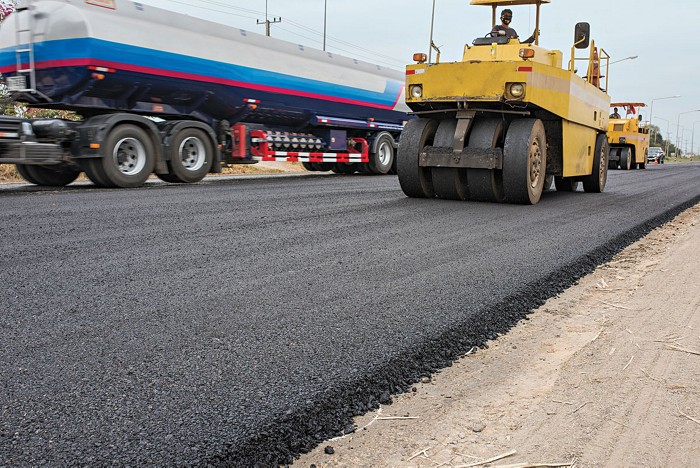Getting The A1 Professional Asphalt & Sealing Llc To Work
Getting The A1 Professional Asphalt & Sealing Llc To Work
Blog Article
Rumored Buzz on A1 Professional Asphalt & Sealing Llc
Table of ContentsA1 Professional Asphalt & Sealing Llc Can Be Fun For AnyoneThe Buzz on A1 Professional Asphalt & Sealing LlcThe 9-Minute Rule for A1 Professional Asphalt & Sealing LlcA1 Professional Asphalt & Sealing Llc Fundamentals ExplainedLittle Known Facts About A1 Professional Asphalt & Sealing Llc.

The oil in a cars and truck engine is not simply oil. It contains a range of ingredients to boost the vehicle's efficiency. These consist of polymers, thickness modifiers, heat stabilizers, added lubes, and wear ingredients. The REOB includes all the ingredients that were in the waste oil as well as the wear metals from the engine (mostly iron and copper).
By making numerous blends using various REOB examples and different asphalt binders, the variants mostly can be averaged out. A number of States offered examples of known REOB make-up to TFHRC researchers, that assessed the samples to contrast the percentage of included (known) REOB to the found (tested) quantity. The evaluations revealed a similar percent of included and located REOB.
Not known Incorrect Statements About A1 Professional Asphalt & Sealing Llc
They got a frustrating action. The TFHRC scientists evaluated 1,532 samples from 40 States, one Canadian district, and 2 Federal Lands Freeway departments. They assessed each example twiceamounting to greater than 3,000 analyses. None of those States realized that the asphalt they were purchasing included REOB. One State insisted its examples had no REOB.
Of the 1,532 examples tested, 12 percent consisted of REOB, and some included appreciably high levels of it at 1020 percent. The highest level was 34 percent in an example from Texas, which TxDOT had actually used in a patching substance. This testing additionally exposed the presence of phosphoric acid in 11 percent of the samples, and 2 percent contained ground tire rubber.
2 years back at TRB's annual conference, the Federal scientists held an REOB workshop and offered the findings of their research laboratory analyses to a standing room-only crowd. Some agencies do not particularly outlaw REOB, they do impose physical tests that prevent its useeffectively a restriction. Others do not ban it by requirements, but have arrangements with asphalt providers to stay clear of making use of REOB
The Buzz on A1 Professional Asphalt & Sealing Llc
A handful do allow REOB, some within certain limitations. For example, Ohio and Texas limit degrees to much less than 5 percent of the asphalt. To create a reputable examination method that all States can use, the TFHRC researchers established up a round-robin test plan. The participants are 11 State freeway firms (Illinois, Massachusetts, Minnesota, Mississippi, Montana, North Carolina, Oklahoma, South Carolina, Texas, i was reading this Vermont, and Wyoming), 2 independent screening labs, the Ministry of Transportation in Ontario, Queen's College in Ontario, and an Ontario paving specialist.
In total, the scientists prepared and delivered 720 blends. The participants are examining the examples independently utilizing the guidelines offered by the TFHRC scientists. The round-robin screening is almost completed, and TFHRC remains in the procedure of collecting the results. The result will certainly be a suggested AASHTO examination method that any kind of State can adopt and use (asphalt repairs).
The sidewalk with REOB, which is located 0.6 mile (1 kilometer) from the pavement without REOB, has similar subgrade, website traffic density, and environment. The section of Highway655 with 5 to 10 percent REOB showed substantial breaking. In this example, the existence of REOB was the recognized root cause of fracturing at a low temperatures.
An area of examination sidewalk in Minnesota (MN1-4) discovered to include REOB likewise cracked too soon. The pavement performed well for the very first 3 to 4 years, yet after that began to break.
A1 Professional Asphalt & Sealing Llc Things To Know Before You Buy
The examinations were not extensive, yet they revealed that at levels of 6 percent or even more, the tensile stamina of the asphalt went down significantly. At a degree of 3.5 percent REOB, the variant in the physical test methods was above the result of REOB. As a matter of fact, it was difficult for researchers to assess whether REOB was existing.

One binder specification taken into consideration is the distinction between the reduced temperature level essential spec temperature level for tightness (S) in the bending beam rheometer and the flexing beam of light rheometer creep slope (m-value) noted as Tcritical. 2 independent research study teams, one from AASHTO and the various other from the Asphalt Institute, wrapped up that even more study is needed on the use of REOB in asphalt.
Previously, all asphalt screening measured design properties such as tightness. These tests do not show what products had actually been included to the asphalt. One sample obtained during the TFHRC study had an extremely unusual analysis. The example had the following examination results: Superpave PG 64-28 with a high temperature level grade of 67.3 Tcritical on the flexing beam rheometer was 6.7 levels Celsius.

A1 Professional Asphalt & Sealing Llc for Dummies
These outcomes show there are weaknesses in the standardized engineering screening procedures that might be made use of. The manufacturer may have a financial benefit and the item passes all the standardized examinations, but the item might not be helpful to making certain long-term performance. To resolve this problem and the growth of new asphalt ingredients and extenders, TFHRC is beginning a study program to use handheld spectroscopic devices, x-ray fluorescence spectroscopy, and Fourier change infrared spectroscopy to make it possible for analyses to be performed in the area rather than needing to take examples back to the lab.
Report this page